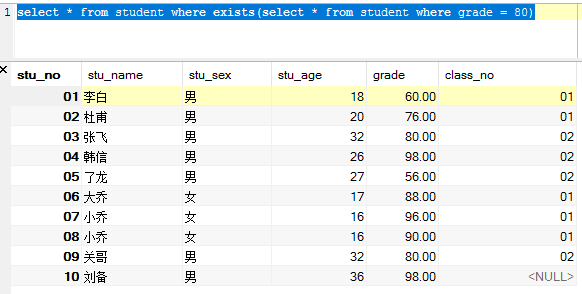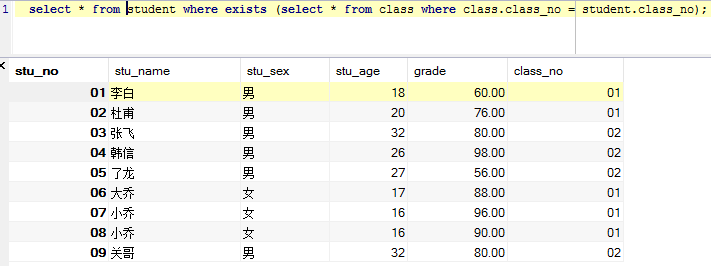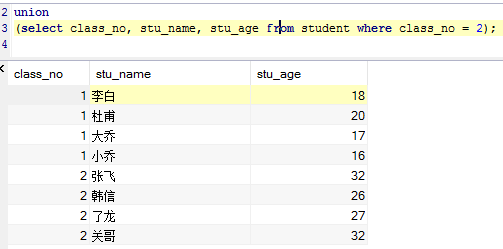废话不多说,直接进入正题
#数据准备
班级表class:
CREATE TABLE `class` ( `class_no` int(2) unsigned zerofill NOT NULL AUTO_INCREMENT COMMENT '班级编号', `class_name` varchar(30) CHARACTER SET utf8 NOT NULL COMMENT '班级名称', PRIMARY KEY (`class_no`) ) ENGINE=MyISAM DEFAULT CHARSET=latin1;
insert into class values(1, '培优班'); insert into class values(2, '普通班'); insert into class values(3, '提升班');
学生表student:
CREATE TABLE `student` ( `stu_no` int(2) unsigned zerofill NOT NULL AUTO_INCREMENT COMMENT '学员编号', `stu_name` varchar(30) CHARACTER SET utf8 NOT NULL COMMENT '学员姓名', `stu_sex` varchar(3) CHARACTER SET utf8 NOT NULL COMMENT '学员性别', `stu_age` tinyint(2) unsigned zerofill DEFAULT NULL COMMENT '学员年代', `grade` double(5,2) unsigned zerofill DEFAULT NULL COMMENT '成绩', `class_no` int(2) unsigned zerofill DEFAULT NULL COMMENT '所在班级编号', PRIMARY KEY (`stu_no`), KEY `class_no` (`class_no`) ) ENGINE=MyISAM AUTO_INCREMENT=11 DEFAULT CHARSET=latin1; insert into student values(01, '李白', '男', 18, 60, 01); insert into student values(02, '杜甫', '男', 20, 76, 01); insert into student values(03, '张飞', '男', 32, 80, 02); insert into student values(04, '韩信', '男', 26, 98, 02); insert into student values(05, '了龙', '男', 27, 56, 02); insert into student values(06, '大乔', '女', 17, 88, 01); insert into student values(07, '小乔', '女', 16, 96, 01); insert into student values(08, '小乔', '女', 16, 90, 01); insert into student values(09, '关哥', '男', 32, 80, 02); insert into student values(10, '刘备', '男', 36, 98, null);
1: exists子查询
如果子查询有返回结果则为true,如果没有返回值则为false
select * from student where exists(select * from student where grade = 80)

比如not exists:
select * from student where not exists(select * from student where grade = 80);
以上结果返回空,因为 not exists 返回了 false
select * from student where exists (select * from class where class.class_no = student.class_no);

上面的查询可以看到,我们少了一条数据,第十条的clas_no 是null。。。所以这条数据是flase....而
class.class_no = student.class_no 为true的,就全部返回了
2: [union] 并合查询
需求: 拿到01班级的最高成绩 和 02班级的最低成绩
我们一般会这样
select max(grade) from student where class_no = 01; select min(grade) from student where class_no = 02;
优化这个查询我们可以这样:
(select concat('1号班级最高成绩:', max(grade)) '成绩' from student where class_no = 01) union (select concat('2号班级最低成绩:', min(grade)) '成绩' from student where class_no = 02);

这里再说下union 和union all的区别:
union:
(select class_no, stu_name, stu_age from student where class_no = 1) union (select class_no, stu_name, stu_age from student where class_no = 2);

union all:
(select class_no, stu_name, stu_age from student where class_no = 1) union all (select class_no, stu_name, stu_age from student where class_no = 2);

通过以上两个查询,我们可以看到:union并合查询它会自动的去重复的记录, 如果不想要去掉重复的记录则可以使用 union all;
我们加个排序:
(select class_no, stu_name, stu_age from student where class_no = 1) union all (select class_no, stu_name, stu_age from student where class_no = 2) order by stu_age desc;

连接查询的分类
1: 内连接
2: 外连接
3: 自然连接
1: inner join(内连接)
需求: 查询出学员的学号, 姓名, 所在的班级名称
select stu_no, stu_name, class_name from student join class where `student`.class_no = `class`.class_no;

以上sql等同于:
select stu_no, stu_name, class_name from student join class where `student`.class_no = `class`.class_no; select stu_no,stu_name,class_name from student,class where student.class_no = class.class_no;
内连接的inner字符可以不用写
2: cross join(交叉连接,迪卡尔集) 没有条件的内连接
例: select * from student cross join class;
例: select * from student inner join class;
例: select * from student cross join class where `student`.class_no = `class`.class_no;
ps: cross join 与 inner join 在使用上没有区分,只是在mysql中把cross join定义成交叉连接而已
就写到这把。。其他的连接方式也简单,资料也很多啦。。。